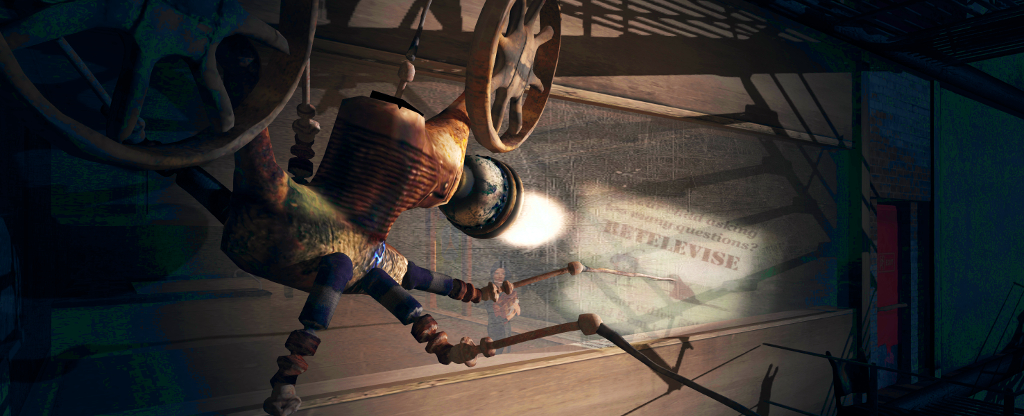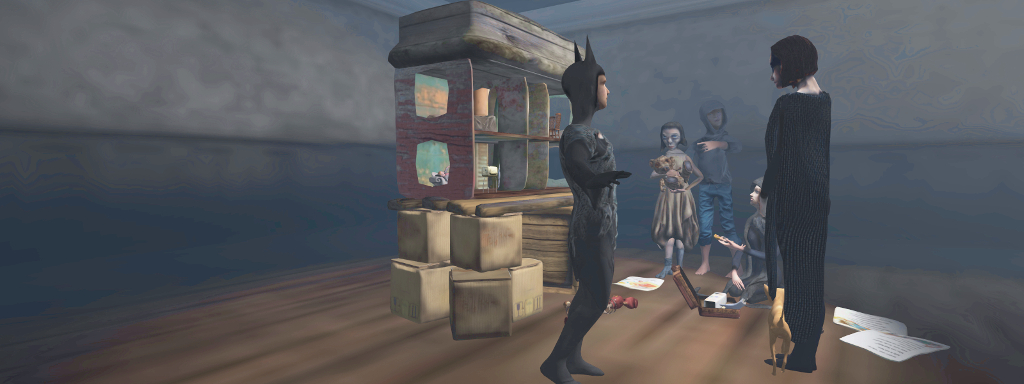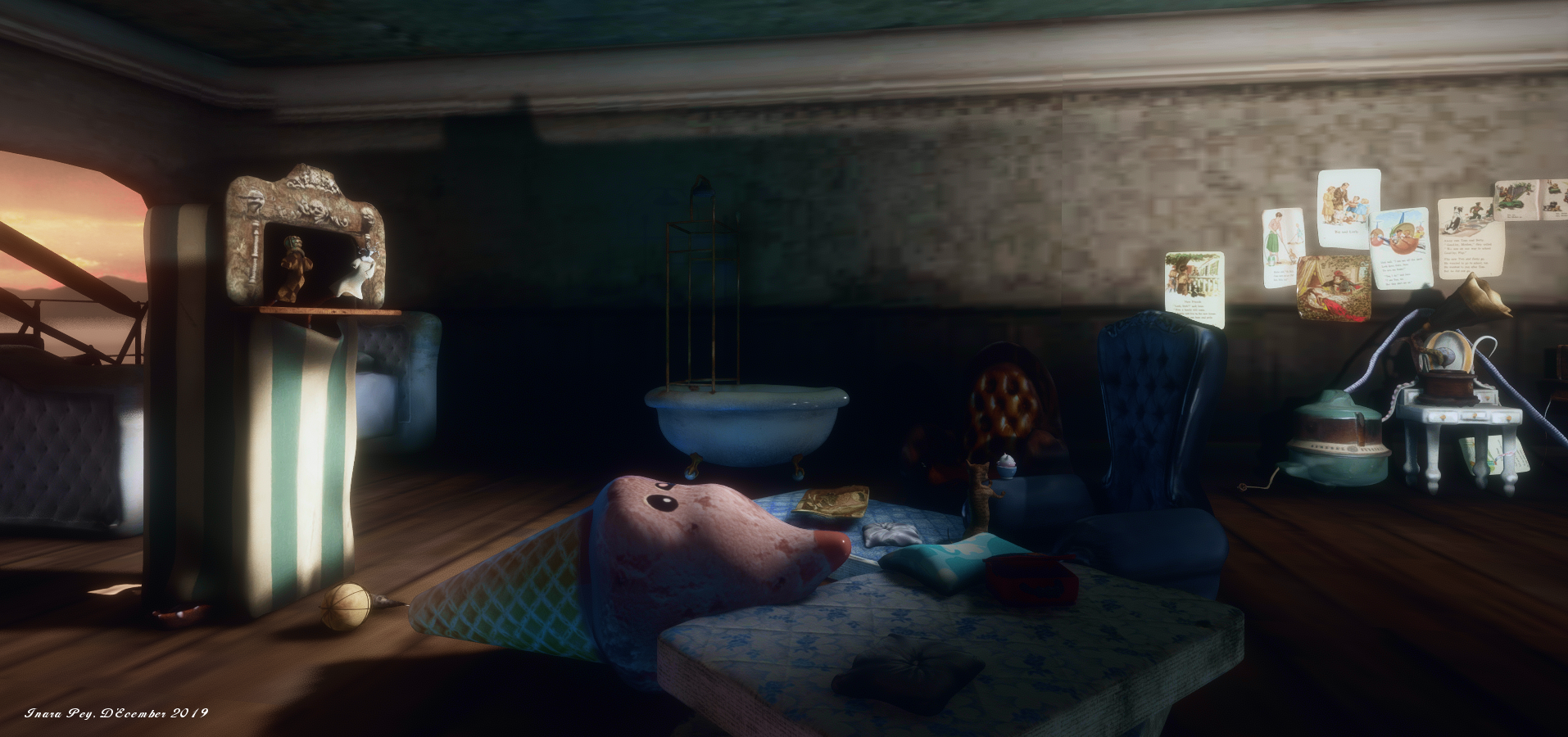
Bryn Oh’s Hand first appeared in Second Life is 2016, located on her arts region of Immersiva. At the time, it proved a highly popular installation, likely thanks to its nuanced tale that straddled the light and the dark places of life and offered a commentary on the possible future relationship between physical and virtual life. More recently, Bryn rebuilt Hand entirely in mesh for Sansar, taking advantage of that platform’s particular capabilities, before porting the mesh build back to Second Life and her home region of Immersiva, giving it a new lease of life there, using SL’s particular presentation strengths.
As with much of Bryn’s work and such is her standing as an artist, Hand has been supported by a grant from the Ontario Arts Council – a part of which has required Bryn produce a machinima of the installation; and she is offering members of her Patreon group and readers of this blog an advanced viewing of the film, which you can find at the end of this article.
Hand is the story of a time when society transitioned to living and working in the virtual space. In this society people housed their bodies in inexpensive pods hooked up to food cannisters. They discarded their houses and furniture as they were no longer needed. They evolved past their physical bodies and lived digitally as the person they wanted to be. Overseeing all of this is a singularity AI named Milkdrop, first seen in the Singularity of Kumiko, though only now revealed to be an AI.
– Bryn Oh on Hand

In this, Hand, whilst an accessible piece in and of itself, offers a deeply layered story that reaches beyond its own pages. At its core, it is the story of children who have been left out of the VR “nirvana” entered into by adults, and who must fend for themselves. largely surviving by “borrowing” the condensed food used to feed the VR “dreamers” in their pods. For these children, any understanding of life and the world around them comes purely through the ideas of fairy tales and ancient copies of Dick and Jane books. They believe that the dreamers, like Sleeping Beauty, will one day awake and rejoin them – but until that time, they must strive to maintain life and family through the simple, idealised writing found in Dick and Jane.
We follow this story through the character of Flutter, a young girl who yearns for the touch and companionship of a mother. She sates some of this need through the plastic hand of a shop window mannequin, holding on to it as though it were the hand of a mother figure with whom she converses. Through Flutter and her conversations, we are connected to the rest of this world – a place that is perhaps unpleasant to both the rational and the emotive mind, both which may recoil from the themes offered. But that’s intentional; Hand is not supposed to be black-and-white. Rather, and like all of Bryn’s work, it is intended to provide a narrative and to challenge perception and raise questions.

The layering evident in the tale is highly nuanced, some of it contained within the central story, other elements reaching beyond it. For example, within the story we have the subtle parallel of between “dreaming” adults and awake children. The former have escaped reality into a virtual existence, whilst the latter find a more acceptable order to their reality by framing it in terms of the fictional happy family ideal of Dick and Jane.
But beyond, this, Hand reaches into the rest of Bryn’s immersive universe. As she noted herself, the AI Milkdrop is actually first witnessed in The Singularity of Kumiko (2016). It is also, perhaps, the intelligence that assisted human scientists create the robots from 26 Tines (2017), while those same scientists constructed the Rabbicorn we see in The Daughter of Gears (first seen in 2011 and again 2019), whilst the laboratory they use harkens back to 2011’s Standby.
Thus is it possible to bring these stories together on a time line, one in which Hand takes place some 120 years after The Daughter of Gears was built by her grieving mother, but only 20 years after the Rabbicorn discovered her in her Standby, whilst little more than a decade has passed since the events of The Singularity of Kumiko.
With my work I build for different types of people. There are those who have followed my work and know how to search for the deeper layers; they are the “experts”. For them, the story and time line are important. But I also try to build for people who know nothing about the history of the world I have created. So I build in layers: the top layer is for people who know nothing of my work and they enjoy the story on its own; the next layer is the story and then concepts within the story and the final layers are where the story fits into the time line.
– Bryn Oh
This broader layering is also reflected in some of those we meet in Hand, such as Milkdrop. Then there is also the character of Juniper, hidden under her blankets, and whom Flutter stops to visit on her way home. She is the central character in Bryn’s 2013 poem and machinima of the same name, and who also forms a part of Imogen and the Pigeons. Thus, through Hand, we discover more about Juniper’s huddled existence and why, in so strange and lonely world, she finds such security and comfort under her hole-riddled blankets.

Whilst stories in their own right, all sharing a common universe, there is something more within each of Bryn’s installations and pieces which reflects her thoughts and feelings in an almost journal-like fashion.
My work is almost a type of diary. I take things from my life or observations on society and incorporate them into the ongoing narrative. The idea is to create a parallel society we can recognise, but use very personal or emotional aspects of my own life to connect to the viewer. So as an artist if I take something from my own life, something I understand deeply and personally, I can convey that emotion to the viewer better than an idea that I have not lived. The first hand experiences let me detect the nuances that may be lost if I were to attempt to create something that I had not experienced.
– Bryn Oh

As immersive pieces, Bryn’s works are also somewhat experiential, in that they often involve a lot of activity on the part of visitors. This is again intentional, as Bryn noted to me: having to work for something results in a deeper attachment to an installation, a sense of achievement on gains success, together with a personal connection to the story through that achievement. It may not be something that appeals to everyone, but it is something that undoubtedly adds significantly to the ability of her work to keep people visiting and in making repeated visits.
When looking at Bryn’s work as a whole, it is not unfair to say that she has, over 13 years, become one of the world’s foremost virtual artists, and through her work in Second Life, Sansar and other virtual mediums and environments – including the use of machinima as seenat the end of this article -, she is very much a pioneer in shaping a new artistic movement.
We had the Cubists, Impressionists, Surrealists, Modernists and I see our movement as the Immersivists. I have believed in this idea a long time but now with virtual reality headsets such as Vive or Oculus, the immersion is less fragile. You don’t look at a computer screen and beyond its borders see a bill that needs to be paid or your cell phone rings… instead you are in the world I have created and firmly there. Unlike painting where you stand from a distance and look at a static scene or cinema where you are told a story as a passive observer, virtual reality artwork can offer the ability to be an active participant in the art.
– Bryn Oh
As a pioneer, Bryn herself faces many challenges, up to and including being able to finance her virtual work. In this, she is keen to note the on-going support of the Ontario Arts Council, which has been vital to Hand’s renewal in Sansar and Second Life, as well as supporting her in some of her other installations and work.
Hand took me almost a year to build; to undertake a project like this with potentially few prospects is, as you can imagine, unwise. So the financial support of the Ontario Arts Council helps enormously. But what is more important to me is the psychological support they provide through their belief in me as an artist. I work alone; few among my family and friends understand what I do, nor are they particularly curious … Recognition by, and support from, the OAC, is something that reinvigorates my confidence and says to keep going and striving in this art medium that I truly believe in. So I would like to thank again the OAC and the great work they do.
– Bryn Oh
A further reflection of the depth and importance of Bryn’s work also lies in the fact that professor Carolyn Steele of the Communication and Culture department at York University, Toronto, is putting together a new course on Bryn’s work that will be presented at the university in the near future.
For those of us unable to attend that course, we still have Hand to appreciate in Second Life and Sansar – and, doubtless, more stories to come out of Bryn’s universe. So for now I’ll leave you with the aforementioned video, as produced for OTC, and also offer my thanks to Bryn for all of her work in Second Life and Sansar, which means a lot to so many, and for giving me the time to answer questions and discuss her work in order to produce this article.
Related Links
- Hand in Second Life (Immersiva, rated: Moderate)
- Hand in Sansar
- Bryn Oh’s blog
- Bryn Oh’s Patreon










